Features
By Dr David M. Lyreskog, Postdoctoral Researcher, Department of Psychiatry
People across the world are looking forward to the greatest sporting event on earth: the Olympic Games. Although it may look and feel quite different this time due to the COVID-19 pandemic, it serves as a source of inspiration for millions of adults, children and young people alike. The athletes competing in the coming weeks mount a tremendous responsibility on their shoulders. Representing the pinnacle of human performance, Olympians are not merely idolized for their athletic abilities, but also often praised for their moral character, sportsmanship, and/or mental resilience.
We like to think that athleticism and doing sports is good for us, as it can offer a sense of achievement, and teach us valuable skills such as perseverance and team spirit. People are inspired by incredible athletes and their achievements; however, do these athletes make appropriate targets of aspiration – for young people in particular?
Exercise vs sports
Exercise and top-level sports differ in some significant ways. Where exercise has proven over and over again to be an excellent means to promote not only physical health, but also well-being and mental health, professional sports may not be very healthy.
During the Olympics alone, about 11% of the athletes incur injuries. In elite sports teams, the prevalence of depression and anxiety is sometimes as high as 45%, and in adolescent elite sports the prevalence of eating disorders is approximately 14%. The pursuit of performance – of excellence – does not appear to be a healthy one.
 Olympic gold-medallist Simon Biles recently withdrew from gymnastic events at the Tokyo 2020 Olympics to 'focus on her mental health'.
Olympic gold-medallist Simon Biles recently withdrew from gymnastic events at the Tokyo 2020 Olympics to 'focus on her mental health'. I have to focus on my mental health...we have to protect our minds and our bodies and not just go out and do what the world wants us to do...There were a couple of days when everybody tweets you and you feel the weight of the world.
Simone Biles, Team USA gymnast
Exercise is commonly prescribed for reducing symptoms of depression and anxiety in young people. Alongside getting adequate amounts of sleep and adhering to a balanced and healthy diet, exercise arguably qualifies as one of the most important low-risk interventions to promote mental and physical health. And sports is probably the most common way for young people to exercise consciously, be it for physical or mental health, or just for fun. But that does not mean that all sports is exercise. It goes without saying that there are massive differences between your everyday sport enthusiast who exercises for health, and an Olympic-level athlete.
Health vs performance
While most of us are probably aware that Olympic-level sports may not always be healthy, it is less clear to us exactly when exercise for health turns into sports for performance and excellence. Indeed, one of the alluring features of sports is the direct feedback indicating improvement: the possibility of playing better than last week, running further and swimming faster than yesterday – doing better – is part of why we get out there at all.
But therein lies the crux: doing better performance-wise does not necessarily mean doing better in terms of mental and physical health. In fact, it can be detrimental to it. Sports is a difficult concept in this domain, because there is no clear line for us to pass between exercise on one side, and performance-based and risk-inducing training on the other. And of course, that line will be differently placed for different individuals.
Promoting physical and mental health
What are the key mechanics which underlay shifts in motivation, and how can we direct everyday sports and exercise towards levels and types of activity which promote physical and mental health?
It is clear that more research needs to be done in this area to help young people in particular strike a balance in exercise and sports. Perhaps the best we can do for now is to try to be aware of the motives and behaviours from ourselves and those around us, and to try to support healthy forms of exercise in the general population. Because, as impressive and inspiring as the performances on the Olympic stage are, they are not doing wonders for the health of the athletes.
All the focus on children over the last year has been about lost education, keeping them busy and the impact of isolation. Right now, it is holidays and exams. But we should be more worried – a lot more worried.
Lucie Cluver, Oxford Professor of Child and Family Social Work, says Dr Susan Hillis, from the US Centers for Disease Control and Prevention, was so worried, she could not sleep. The thing is, children may not be dying from COVID-19, but millions have already or will lose parents and caregivers before the pandemic ends, creating an epidemic of orphan-hood in the wake of the virus. And that was keeping Dr Hillis awake at night.
Children may not be dying from COVID-19, but millions have already or will lose parents and caregivers before the pandemic ends, creating an epidemic of orphan-hood in the wake of the virus.
‘The global response has focused on adults, because that is who the disease is striking,’ says Professor Cluver. ‘But there has been no thought at a global scale about the impact of COVID deaths on children. This needed a concerted effort.’
Not long after that phone call, an international team of academics and policymakers came together, and the results of their work is published in the Lancet.
It is obvious when you think of it. Just as with AIDS and Ebola, the virus was going to leave children around the world without parents – and/or grandparents. Devastating for families and children and very costly for countries, in every sense. COVID-19 is far from over.
The global response has focused on adults, because that is who the disease is striking...But there has been no thought at a global scale about the impact of COVID deaths on children. This needed a concerted effort...we needed robust evidence
Professor Lucie Cluver
Dr Hillis emphasised they needed to work swiftly. But, before they could ask for help, they needed to know the size of the problem – and the locations.
'We needed robust evidence before we could ask for a strong response,’ says Professor Cluver.
What they really needed was the world’s best modellers, to work out the scale of the crisis. Professor Cluver had a not-entirely-scientific thought: maybe a dad at her children’s nursery in St Anne’s College could help? In normal times, you might ask a toddler’s dad for a playdate. But Dr Seth Flaxman was also a statistician at Imperial College, part of the team crunching COVID numbers, and soon to come to Oxford’s Department of Computer Science. So it was not quite as outlandish as it sounds.
As soon as he understood, Dr Flaxman brought together a team to work on the problem at Imperial and Oxford – including Professor Christl Donnelly, who works at both universities. Their series of papers, looking at the impact of COVID on countries around the world and at the fallout from new variants, were guiding national responses.
In previous studies, on disease burden, they had calculated global estimates, by combining dozens or hundreds of national surveys. But no surveys were being undertaken on children affected by the deaths of their parents or caregivers, so demographic methods were needed to combine data on average family sizes with COVID death information.
Given the heavy burden of deaths among older age groups, Professor Cluver says, ‘We needed to think about grandparents as well. There has been a huge increase over the last decade in children being looked after by grandparents. In many households, they are primary caregivers, and provide essential financial support.’
We focused on 21 countries with the highest numbers of COVID deaths, looked at age and fertility patterns and extrapolated to the rest of the world to find minimum estimates of the number of children affected
Dr Seth Flaxman
Dr Flaxman explains, ‘We focused on 21 countries with the highest numbers of COVID deaths, looked at age and fertility patterns and extrapolated to the rest of the world to find minimum estimates of the number of children affected.’
Alongside the calculations, the project has brought together international institutions including the CDC, the WHO, the World Bank, and USAID. They are leading today’s publication of the research and accompanying report, calling for immediate action from global governments.
The team is well aware what is at stake... According to Professors Lorraine Sherr and Charles Nelson, research shows, institutions are really terrible for children...it is much better to support the extended family to care for them.
The team is well aware what is at stake. With memories of the impact of the AIDS epidemic in Africa, when there was a rush to put orphans into institutions, they are concerned this does not result in a rush to separate children from families again.
UCL’s Professor Lorraine Sherr and Harvard Professor Charles Nelson insist, ‘Research shows, institutions are really terrible for children...it is much better to support the extended family to care for them. Almost every child has a family member who could do that.’
On a purely financial basis, the cost of institutionalising the COVID orphans is seven times greater than the cost of keeping them at home. With today’s Lancet release, Dr Flaxman and Professor Cluver hope policymakers will act to avoid the crisis becoming a long term catastrophe. It means taking country-by-country action to keep children out of institutions and with their families.
On a purely financial basis, the cost of institutionalising the COVID orphans is seven times greater than the cost of keeping them at home.
Dr Flaxman and Professor Cluver hope policymakers will act to avoid the crisis becoming a long term catastrophe
‘There needs to be support for children,’ says Professor Cluver. ‘But there are effective and affordable responses. If we make sure that families have some financial support, that children can go to school, and that they have help with parenting in these difficult circumstances, then children do better in many important aspects of their lives. But we need to act fast.’
There are some steps everyone can take. If parents and grandparents are vaccinated, then their children are protected too. When each of us gets our vaccination, we can donate to the World Health Organisation’s COVID solidarity response fund.
But help also needs to come from the international community, and both Dr Flaxman and Professor Cluver are optimistic about the prospects.
This is a call to action to support children who have lost loved ones. Our calculations can help policymakers turn good intentions into appropriately scaled help where it is needed most
Professor Christl Donnelly
‘Even small amounts of support help,’ says Professor Cluver. ‘A grant of $21 a month can benefit a family... a phone-based parenting program with support is $6 per child. The costs are manageable.’
Dr Flaxman’s open-source online calculator shows minimum estimates for the numbers of orphaned children per country and a country graph indicates the increase in numbers during the pandemic. At the time of writing, the numbers already orphaned in South Africa, for instance, was 101,400. There are about 10,000 in the UK who had lost at least one care giver.
There are already one million orphans, and 1.8 million children who have lost a caregiver...But with most of the developing world not expected to get vaccines until 2025, there could be five to seven million by the time the pandemic is over...since we submitted the paper, the numbers of orphaned children keep going up and up
Professor Cluver
‘There are already one million orphans, and 1.8 million children who have lost a caregiver’ Cluver explains. ‘But with most of the developing world not expected to get vaccines until 2025, there could be five to seven million by the time the pandemic is over.’
She adds, ‘It’s been a race against time. Even since we submitted the paper, the numbers of orphaned children keep going up and up. Something needs to be done - urgently.’
Professor Donnelly explains, ‘This is a call to action to support children who have lost loved ones. Our calculations can help policymakers turn good intentions into appropriately scaled help where it is needed most.’
Global minimum estimates of children affected by COVID-19-associated orphanhood and deaths of caregivers: a modelling study. (Published Online July 20, 2021). Available once the link goes live: at https://doi.org/10.1016/S0140-6736(21)01253-8)
prepared by the Global Reference Group on Children Affected by COVID-19: Joint Estimates and Action: Susan D Hillis*, H Juliette T Unwin*, Yu Chen*, Lucie Cluver, Lorraine Sherr, Philip S Goldman, Oliver Ratmann, Christl A Donnelly, Samir Bhatt, Andrés Villaveces, Alexander Butchart, Gretchen Bachman, Laura Rawlings, Phil Green, Charles A Nelson†, Seth Flaxman†
Rainforests are amazing places - great biodiverse ecosystems and carbon sinks. But, as a million nature programmes have shown, they are also full of things that could kill you: insects as big as your fist, some of the deadliest snakes alive, even the frogs can be nasty. Not unreasonably, this might well deter many people from venturing into these great forests – but not Oxford professor Yadvinder Malhi. He admits, he likes that sort of thing...a lot. It is not just the biodiversity which attracts the professor of Ecosystem Science, but the challenging nature of doing research there, the fact we still know so little about them and the major role rainforests have to play in our climate.
A million nature programmes have shown, rainforests are full of things that could kill you...Not unreasonably, this might well deter many people from venturing into these great forests – but not Oxford professor Yadvinder Malhi. He admits, he likes that sort of thing...a lot
Until the pandemic, Professor Malhi had spent years in and around tropical rainforests, visiting field research sites most years. He took his young family on holiday to one dense forest deep in Borneo and only went to the beach, reluctantly, after his son protested at the idea of even more time in the rainforest. This year, though, he has been a stay-at-home academic, with the most challenging environment being Oxford and the University’s Wytham Woods (actually a very interesting place to study, says the professor).
It is a far cry from where the genial professor grew up: darkest Essex. Although, when he was around six, the young Yadvinder’s parents sent him to live with his grandparents in the Punjab for a year – so he would understand his Indian roots. Life could not have been more different (and more challenging), but Yadvinder discovered an intense life in full colour surrounded by warm, welcoming people – and his love affair with tough places and nature began.
‘I saw the world open up for me,’ he says. ‘It made me want to explore the whole world.’
He recalls how his cousins would bring him local birds and animals to inspect, catching parrots in basket traps, so the budding young scientist could inspect them. After a year, he returned to monochrome Essex, more interested than ever in the scientific world, and told his incredulous classmates about one discovery, ‘There are more brown people in the world than white.’
'They did not believe me,' he laughs. Yadvinder's keen interest and scientific ability, took him from his local school to Cambridge in the late 1980s, to study Physics.
‘I wanted to study astronomy,’ he says. Awareness of the issue of climate change was in its infancy, but he was beginning to think that maybe environmental science, rather than the stars, was for him.
‘There is a tradition of physicists going into biology,’ he adds. ‘I’ve learned a lot in the process.’
Going to Edinburgh after his doctorate, the young researcher took his first big step into the natural world, with a study visit to Brazil. He learnt Portuguese (though his samba didn’t improve much) while waiting for his equipment to clear customs (it took three months). But the main point was to work in the rainforest.
‘We worked on a scaffolding tower in the middle of the Amazon,’ he says, reminiscing fondly. ‘We measured the rain, air and water....this was the first time I had been in a rainforest. I loved it all, the bugs, the big skies, the multitude of living things, everything.’
He adds, ‘There was rainforest for a 1,000 miles in every direction. It’s a continent-sized forest. To see such vast nature and to feel so small - it was transformative.’
There was rainforest for a 1,000 miles in every direction [on his first trip to the Amazon]. It’s a continent-sized forest. To see such vast nature and to feel so small - it was transformative
Professor Yadvinder Malhi
Perhaps with memories of his days as a boy naturalist, he says, ‘There was so much to learn. I was more and more fascinated by ecology.’
He was eager to learn more about ecology – while bringing his physicist’s mindset to the research. Professor Malhi worked largely in Brazil until the early 2000s, when he was invited to look at the potential to do research Peru. He loved that too, ‘I looked at the Andes, it was fantastic. We spent a few weeks, trekking ancient Inca trails.’
On the slopes of the Andes, working with local and international partners, he helped establish a ‘vertical science laboratory’, stretching from the steaming lowland rainforest to the high treeline of the cloud forest, four km up in the atmosphere.
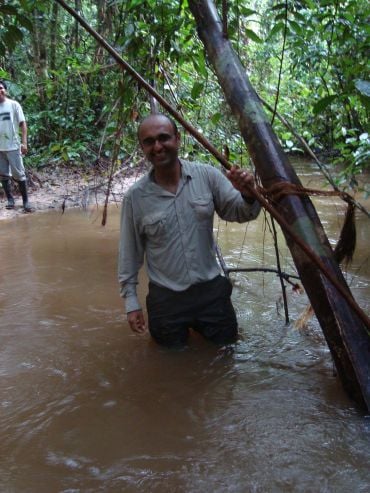 Full of things that could kill you: Yadvinder smiles at the memory of days in the rainforest.
Full of things that could kill you: Yadvinder smiles at the memory of days in the rainforest. He beams as he remembers with evident happy memories, ‘We put study sites all up the sides of the mountains to understand how climate affected tropical forests, and moved plants and soils up and down the mountains [to look at the environment at different levels].’
The same method has now been adopted in other forests from Brazil to Borneo.
‘I was trying to look at the forest as a physicist would, as a system,’ he says.
In 2004, he arrived in Oxford, with a Royal Society fellowship. His work could continue, but he was based, for part of the year anyway, in the city of dreaming spires. Cycling home one rainy Michaelmas day after an intense few weeks of teaching, he missed the outdoors, the forest, the sun. On arriving home, he discovered his wife had been offered an overseas posting – Ghana. He did not need to be asked twice.
Cycling home one rainy Michaelmas day...[in Oxford] he missed the outdoors, the forest, the sun. On arriving home, he discovered his wife had been offered an overseas posting – Ghana. He did not need to be asked twice
‘We went to Ghana for three years,’ he says. ‘I was a stay-at-home father for much of the time, but I used it as a chance to get to understand the forests and people of this continent that was so new to me.’
He adds, enthusiastically, ‘Africa has an unjustified reputation to be really difficult to work in, but once you know people and build local friendships, it can be great and immensely rewarding. I have developed some wonderful long term friendships and working relationships there, and now over half my work is in Africa’
Since the creation of the vertical lab in the Andes, a key part of Professor Malhi’s work has been researching, with partners on the ground, the metabolism of the forest. It is critical work – finding out what is in the rainforest and what is happening – and it is varied from country to country and even within the same forest.
‘We were doing our own research but we realised a global understanding of rainforests was needed, which is where the Global Ecosystems Network (GEM) came in,’ he says.
‘We can see how events, such as El Niño, can lead to carbon pouring into the atmosphere [as the rainforest turns from carbon sink to carbon producer]...half of our plots [study sites] in a key part of the Amazon caught fire and we have been tracking them to see how they recover. These long-term ecological observations are like an ecological weather station, giving us insights into how the forests were and early warning of how they might be changing.’
We can see how events, such as El Niño, can lead to carbon pouring into the atmosphere [as the rainforest turns from carbon sink to carbon producer]...These long-term ecological observations are like an ecological weather station, giving us insights into how the forests might be changing
Professor Malhi
His scientific interest is clearly to the fore as Professor Malhi talks about major weather events, which are becoming more common, potentially having the capacity to turn a massive carbon sink into a carbon producer. The consequences for climate change would be severe. He maintains nature and the rainforest will play a huge role in the battle against climate change, ‘Restoring the rainforest and nature can’t solve climate change, but it can make a substantial and real contribution, while bringing all the many other benefits of a thriving natural world.’
Talking about the new Oxford Martin School Programme in Biodiversity and Society, his particular focus is on better connecting the university to nature restoration projects and plans recovery in the surrounding landscapes of Oxfordshire.
‘We need to do something here locally...the UK’s biodiversity is in a poor state and there’s a lot of potential and new political will to make things better. The experience of lockdown really brought home the importance of local nature. Biodiversity is no longer just thought of as something just nice to have – it’s seen as essential, bringing lots of benefits such as human health and wellbeing, flood control and air quality.’
Restoring the rainforest and nature can’t solve climate change, but it can make a substantial and real contribution, while bringing all the many other benefits of a thriving natural world
Professor Malhi
Professor Malhi is hopeful about the future of the natural world, ‘This is an exciting time. We’re going to see serious efforts to maintain and restore biodiversity...there’s a very positive agenda. It’s no longer about just stopping bad things happening, but about making good things happen.’
And his enthusiasm for research and hard-to-reach places is evident, ‘It’s amazing what you can learn from the countries we work in, from the people who live and work there every day, and from the amazing variety of tropical nature.’
As for him, the Essex boy cannot wait for the pandemic to be over, so that he can head back to where the wild things are, for the sake of science, ‘As a scientist, it’s really important to have a passion, a passion for finding things out – that’s much more important than revising for exams.’
Launching two major pieces of work about meat eating at the same time of year might not sound like ideal timing. But COVID-19 meant that LEAP, Oxford’s Livestock, Environment and People project, was faced with doing just that - launching two projects not only in the same week but on the same day in May. But, actually, it works, according to Lucy Yates, LEAP’s Public Engagement Coordinator.
‘What an opportunity to reach different audiences at the same time,’ she said. ‘By inviting them to Oxford’s Natural History Museum to see Meat the Future and going out to meet a broad range of people around the country with our touring installation, Meat Your Persona.’
LEAP research aims to contribute to an evidence-based discussion on the future of meat production and consumption: how frequently it should be eaten and its environmental and health impact. Some key research findings include:
- Even if we cut all fossil fuel emissions immediately, we still would not reach climate change targets without also cutting food emissions.
- Eating high quantities of processed and unprocessed meat is associated with higher risks of colorectal cancer and ischemic heart disease among other diseases.
Meat the Future offers serious food for thought about how the consumption of meat affects our health and the planet.
Meat the Future offers serious food for thought about how the consumption of meat affects our health and the planet. Showcased in striking, engaging displays, visitors to the museum can find out more about LEAP’s research and learn about the impact of meat eating. Displays include stacks of meat, which compare consumption in different countries. Visitors can browse a supermarket fridge, to find out more about ecolabels for foods, and be transported to the South American rainforest – where biodiversity is under acute attack from agriculture. They can also discover the carbon footprint of their own shopping habits in a specially developed digital interactive.
Professor Sir Charles Godfray, Co-Director of LEAP, Oxford Professor of Population Biology, and Director of the Martin School said, ‘With a population likely to peak above nine billion this century, Meat the Future asks how we square our growing demand for meat with the needs of the planet.’
Meat Your Persona, meanwhile, is a touring installation in a bright yellow horsebox, by design consultancy The Liminal Space. Subtitled ‘What you eat and how it can change the world’, it is also aimed at highlighting the impact of meat eating on the environment and the individual. It offers a fun quiz to find your ‘meat persona’ – such as the BLT or the Happy Eater – and there are a host of other interactive activities designed to help you find out more from new recipes to learning more about Leap’s research.
Meat Your Persona will provide us with invaluable insight into the UK's current thinking around meat consumption and, hopefully, encourage individuals to think more deeply about the impact their food choices have on our environment.
The travelling exhibition is designed to speak to diverse audiences about their meat consumption and be fun along the way.
So far, the yellow horse box has visited shopping centres in Cardiff, Leeds and Newcastle. Blackpool and Glasgow are yet to come - along with a return trip to Leeds.
If you cannot see it in person, can take the quiz and find your meat persona at www.meatyourpersona.com.
Susan Jebb, Professor of Diet and Population Health, Co-Director of LEAP, commented, ‘Most people in the UK are unaware of the environmental impact of meat or the health harms caused by eating too much meat. Meat Your Persona will provide us with invaluable insight into the UK's current thinking around meat consumption and, hopefully, encourage individuals to think more deeply about the impact their food choices have on our environment. This is often a difficult conversation to have, however we feel The Liminal Space has created a positive and engaging way to connect the public to our research.’
The response from the public so far has been very encouraging.
One visitor said, ‘Admiration for a brilliantly put together, very informative exhibition. As a result of this exhibit we have decided to cut beef from our diet for the rest of the family.’
A visitor to Meat Your Persona commented, ‘I am inspired by all the recipes. I think giving up meat would be good for my health so I want to try to cut down.’
After a far busier start to 2021 than she could have possibly imagined, Lucy Yates is delighted both projects have launched successfully and is looking forward to a summer of lively engagement and hearing the public’s thoughts on meat eating.
Come to visit Meat the Future at the Oxford Museum of Natural History or catch Meat Your Persona in Leeds, Blackpool, Glasgow or online. If you are interested in reducing your meat consumption, you can also sign up for our cohort study at www.optimisediet.org.
Wellcome generously support both projects.
In spite of everything, many people still underestimate women, in general, and older women, in particular. They have clearly never encountered Kay Davies, the dynamic 70-year-old Oxford geneticist, who is ‘retiring’ after a lifetime’s research (but not really). Just a few minutes immersed in the company of the self-effacing-but-determined Professor Dame, is enough to make anyone exhausted and put paid to stereotypes about women.
Forget about older women being invisible, you could not miss Professor Davies, who arrives promptly for her interview, lovely in a hallmark brightly coloured jacket
Forget about older women being invisible, you could not miss Professor Davies, who arrives promptly for her interview, lovely in a hallmark brightly coloured jacket (more of which later).
But the professor’s story is even more arresting than her striking appearance. Having arrived in Oxford more than 50 years’ ago, Professor Davies has worked with some of the leading medical scientists of the last half century.
She has been tirelessly at the cutting-edge of genetic science; is close to a cure for a devastating genetic condition – and has found time to be a member of the Council of the Medical Research Council, Deputy Chair of the Wellcome Trust and hold a variety of other posts. Professor Davies has been honoured in the UK (a CBE, followed by a DBE in 2008) and in the US (by the American Society of Human Genetics) – oh...and she has a family.
Being a mother makes you well organised,’ laughs Professor Davies, with typical modesty.
That’s true, of course, but there’s well organised and well organised
‘Being a mother makes you well organised,’ she laughs, with typical modesty. That’s true, of course, but there’s well organised and well organised.
‘I am highly organised,’ Professor Davies admits. ‘Having a child makes you more organised. They come first and you arrange things around that. Mothers achieve so much.’
Professor Davies talks passionately of a lifetime spent researching a cure for Duchenne muscular dystrophy, a devastating genetic condition. Duchenne, which strikes boys, affects one in 100,000 globally and sees sufferers confined to a wheelchair, on average, by the age of 12 and rarely surviving their late 20s.
Professor Davies talks passionately of a lifetime spent researching a cure for Duchenne muscular dystrophy, a devastating genetic condition
It has been a labour of true dedication and many many hours in the lab. Having spent decades on genetic research into the condition, Professor Davies hopes there will be a cure within five years. In fact, she says firmly, she is not going to stop until one exists and, listening to her, you just know, she is going to do it – or someone else.
‘It’s been my life,’ she says. ‘I won’t retire until a cure is found.’
Professor Davies was researching genetic treatments when people still thought histone proteins were on the outside of DNA (they’re not) and she has followed the science through to a place where they are now tantalisingly close to major breakthroughs.
It’s been my life...I won’t retire until a cure is found
Professor Kay Davies
It has been a long journey for the clever girl from a state school in Stourbridge, who came to Oxford at the end of the 1960s to study Chemistry (which she did not really like very much) and then switched to Biochemistry.
It had been a very good all-girls school, she says, with an ‘extremely good’ Chemistry teacher. But the young Kay had not been able to take Biology, because, in those days, you needed Latin to go to Oxford and she could not take both.
‘I was never any good at languages,’ she says. ‘But I was good at Maths. I loved problem solving, which is why they probably accepted me.’
Arriving at Somerville, straight out of school, when many people then took the Oxbridge exam and applied post-A levels, she was among the youngest in her year – and one of the very few women. Although she had plenty of drive, she says, although it was a difficult start: she was ‘shy and not very confident’.
‘There were only a few females doing Chemistry,’ she says. ‘I was the only person from a state-funded school and one of the few from a working class background.’
She laughs, ‘I had something of an inferiority complex, although I was able to do the subject. I had drive, though, I probably got that from my mother. She had a lot of drive.’
I learned style from Mary Archer [a tutor at Somerville], but a lot else as well...I learned to be more ambitious and adopt a can-do attitude
Professor Davies
Oxford’s tutorial system helped the young scholar set aside her reserve. She says simply, ‘It was very competitive. But I found I was surrounded by amazing women.’
The then very young Mary Archer was a tutor at Somerville, ‘She was very driven and meticulously dressed, so stylish and intelligent.’
Professor Davies laughs, ‘I learned style from Mary Archer, but a lot else as well.’
‘I learned to be more ambitious and adopt a can-do attitude,’ she says.
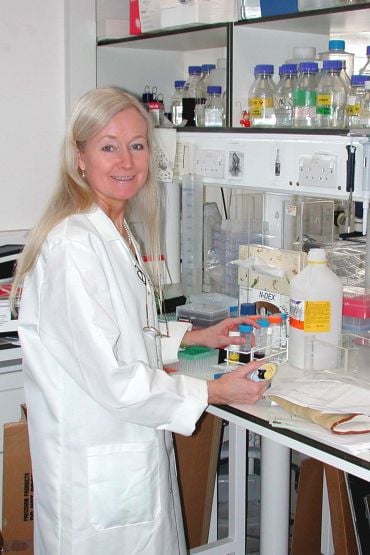 Kay Davies: last day in the lab.
Kay Davies: last day in the lab.Oxford was a very different place in those days, she says, clearly full of enthusiasm about the way the university has changed, ‘It’s a lot more collaborative now than in the 70s. There’s such a buzz now...there are links between the medical sciences and other sciences and the whole thing functions much better.’
It is evidently a heart-felt sentiment. One of the key threads in the professor’s career has been her cross-disciplinary work – which began when she swapped Chemistry for Biology and medical sciences. After completing undergraduate degree, Kay took a DPhil in the very new study of the structure of genes. After completing her doctorate, Professor Davies went to Paris where her husband, later an Oxford professor of Chemistry, had a position.
Dr Davies commuted to London to work in a laboratory at St Mary’s hospital – just near Paddington station.
She says. ‘I got off the train at Paddington and went straight into the lab.’
Though still a young researcher, she worked with some of the pioneers of genetic research. At St Mary’s, she worked for Professor Bob Williamson, the distinguished British geneticist. It was ‘so exciting’, she says, but the cross-country commute was a bit much, even for Kay Davies.
Why Duchenne? Because it affects boys, so we could narrow down where we were looking for the gene, says Professor Davies
But finding and isolating the gene has not been simple
It took an intervention from the Nobel Laureate, genetic code specialist Professor Sydney Brenner, to suggest her return to Oxford. He clearly spotted something in her and decided she should be encouraged. In the days before HR, he picked up the phone and called Oxford.
‘He told them I should have a place...So I moved my fellowship to Oxford in 1984,’ she says.
Whilst in London, Professor Davies alighted on Duchenne. Why Duchenne?
‘Because it affects boys, so we could narrow down where we were looking for the gene,’ she says simply. But finding and isolating the gene has not been simple.
It has needed ‘tenacity and patience’, admits Professor Davies.
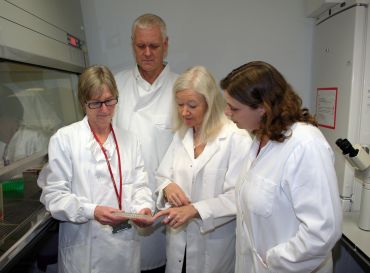 Kay Davies with, left to right: Ally Potter, Dave Powell and Angela Russell
Kay Davies with, left to right: Ally Potter, Dave Powell and Angela RussellIn the event, the gene was found by others and it was ‘very large in the genome sequence’. Then a breakthrough came when a patient in Birmingham was found – who had just 50% of the gene. He had only just been diagnosed and had lived, although he had a milder version of Duchenne, into middle and then old age.
It offered considerable hope for sufferers – if only they could remove part of the gene, replicating the man’s variation. Since then, others have come forward with similar mild symptoms, says Professor Davies, who has become close to many families and charities involved in the debilitating condition.
It needs more screening of molecules for our approach to therapy...We screen a lot of molecules with the help of Angela Russell’s group in Chemistry. And we might end up curing those boys
Professor Davies
‘As a team, we’re very committed,’ she says.
They have to be. Finding a way to change the gene, for those with full-blown Duchenne was never going to be easy. Sufferers are living longer now, thanks to better treatments, but few live to see their 30th birthday.
‘It needs more screening of molecules for our approach to therapy,’ she says. ‘We screen a lot of molecules with the help of Angela Russell’s group in Chemistry. And we might end up curing those boys.’
The gene therapy treatment could also be potentially used to treat other forms of Muscular Dystrophy, Professor Davies says with real passion.
And that’s the key, she says, Passion, ‘This isn’t work...you have to do what you’re passionate about and it will work out. And don’t feel bitter when people knock you back.’
It’s an important thought because, on many occasions during her career, she has been the only woman in a room of dark-suited men. Professor Davies laughs as she says she was occasionally mistaken for a tea lady, ‘You can’t feel bitter about it, that’s why I buy bright jackets. No one mistakes me for a tea lady anymore.’
- ‹ previous
- 16 of 247
- next ›

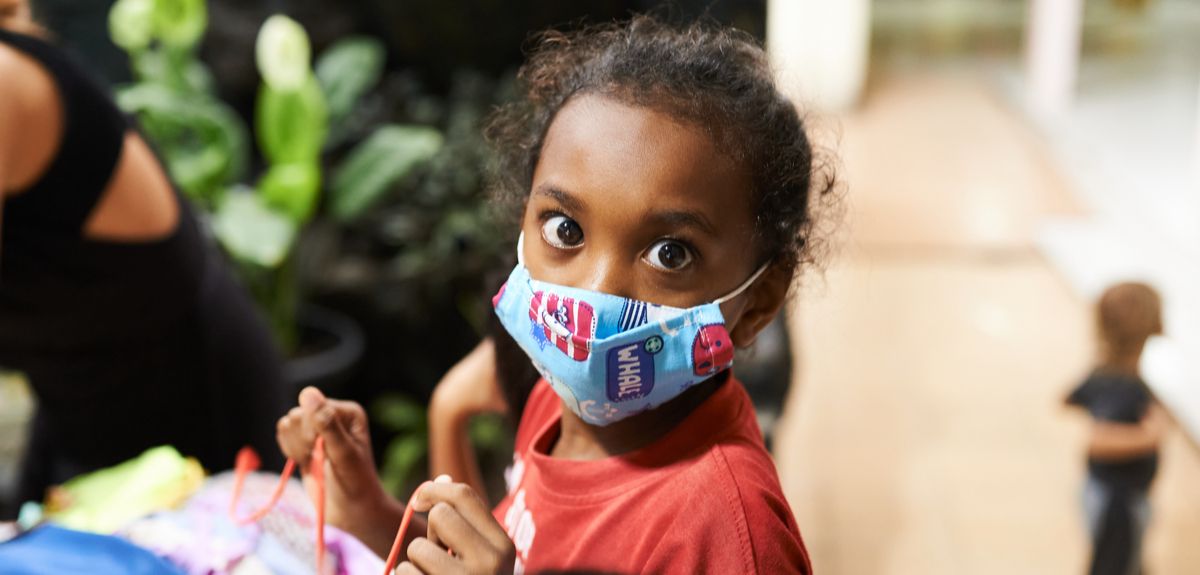
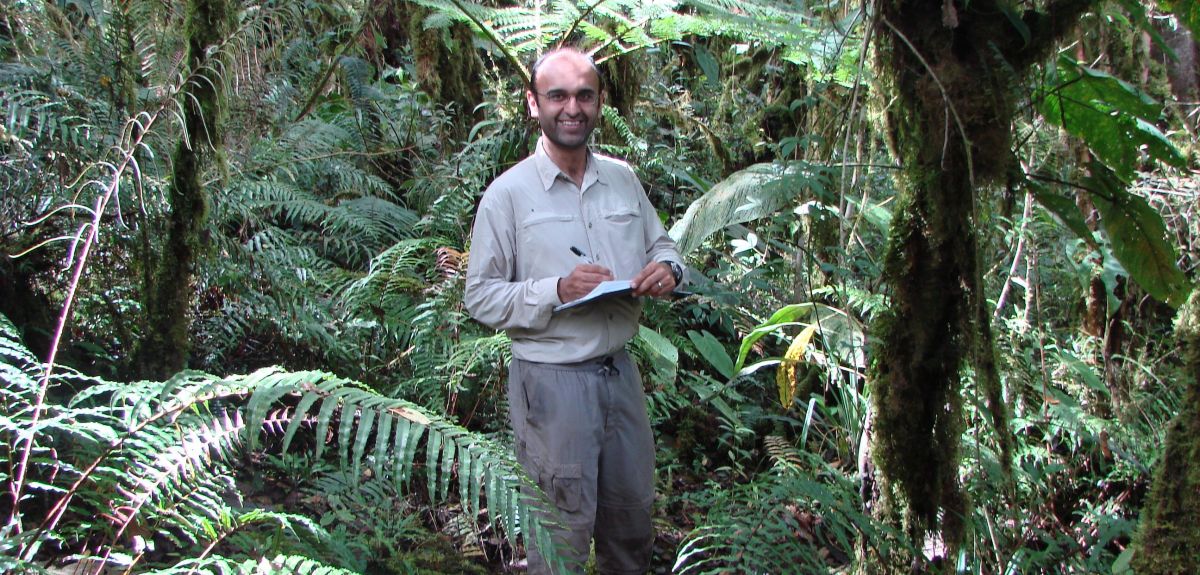
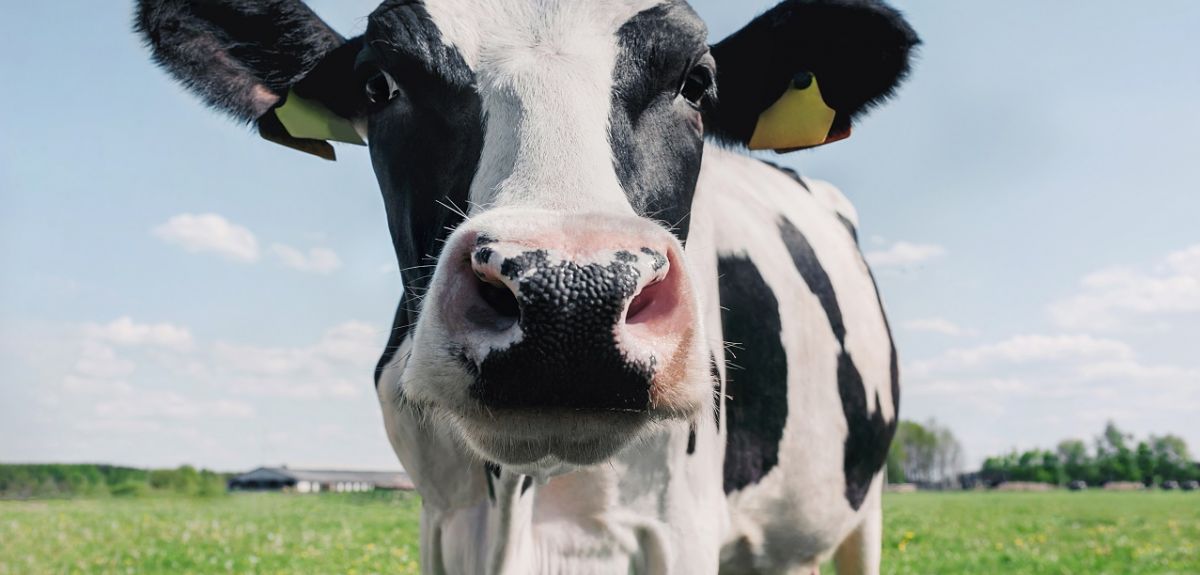
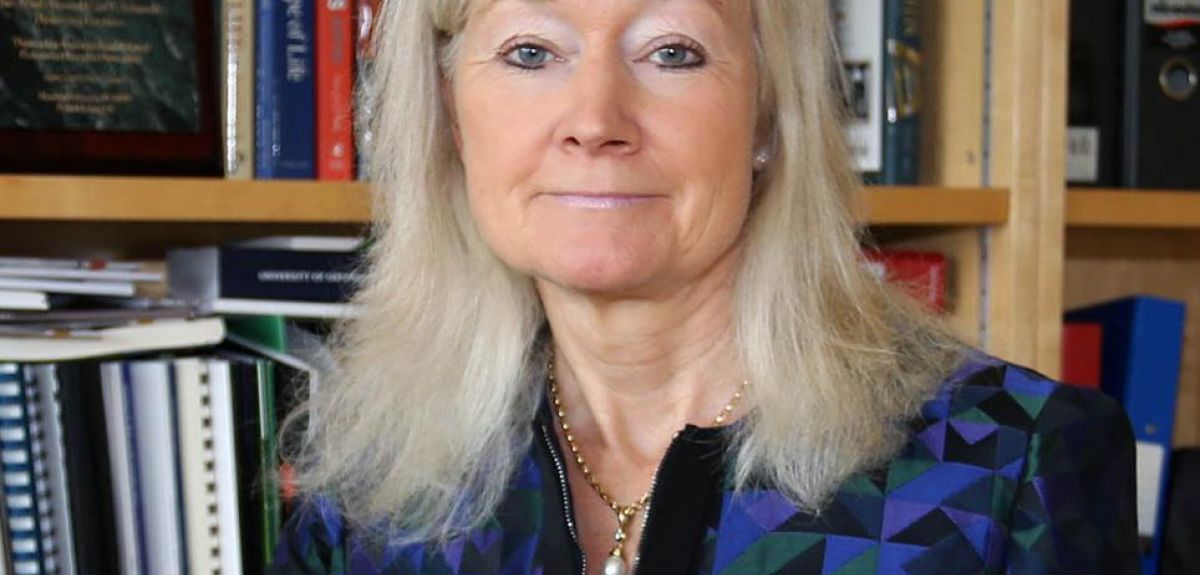
 World Malaria Day 2024: an interview with Professor Philippe Guerin
World Malaria Day 2024: an interview with Professor Philippe Guerin From health policies to clinical practice, research on mental and brain health influences many areas of public life
From health policies to clinical practice, research on mental and brain health influences many areas of public life From research to action: How the Young Lives project is helping to protect girls from child marriage
From research to action: How the Young Lives project is helping to protect girls from child marriage  Can we truly align AI with human values? - Q&A with Brian Christian
Can we truly align AI with human values? - Q&A with Brian Christian  Entering the quantum era
Entering the quantum era Can AI be a force for inclusion?
Can AI be a force for inclusion? AI, automation in the home and its impact on women
AI, automation in the home and its impact on women Inside an Oxford tutorial at the Museum of Natural History
Inside an Oxford tutorial at the Museum of Natural History  Oxford spinout Brainomix is revolutionising stroke care through AI
Oxford spinout Brainomix is revolutionising stroke care through AI Oxford’s first Astrophoria Foundation Year students share their experiences
Oxford’s first Astrophoria Foundation Year students share their experiences